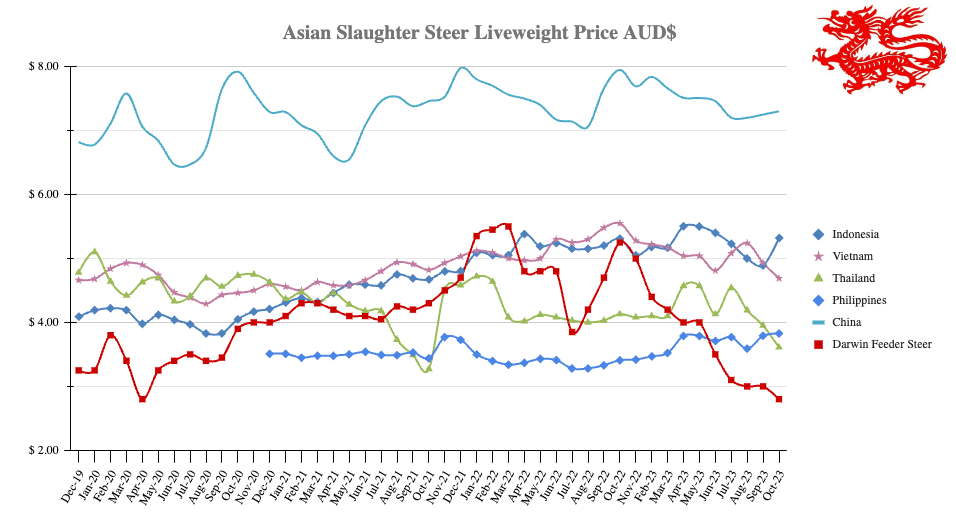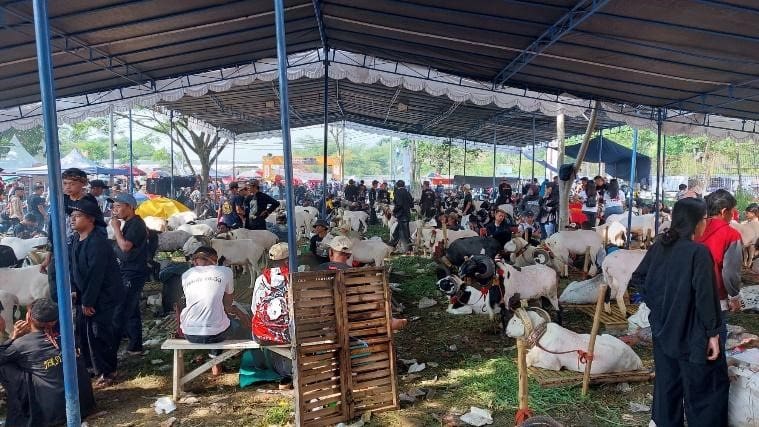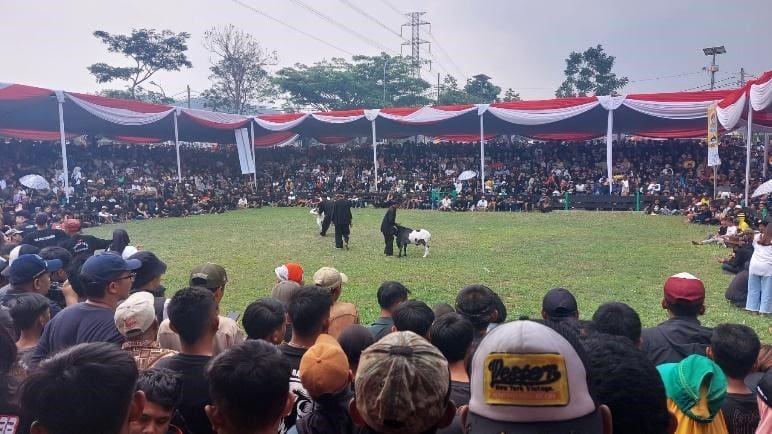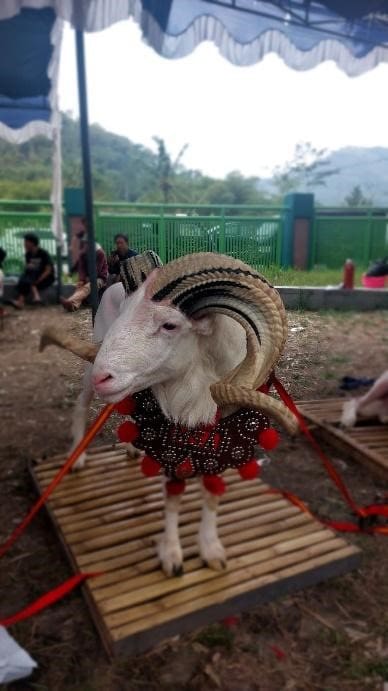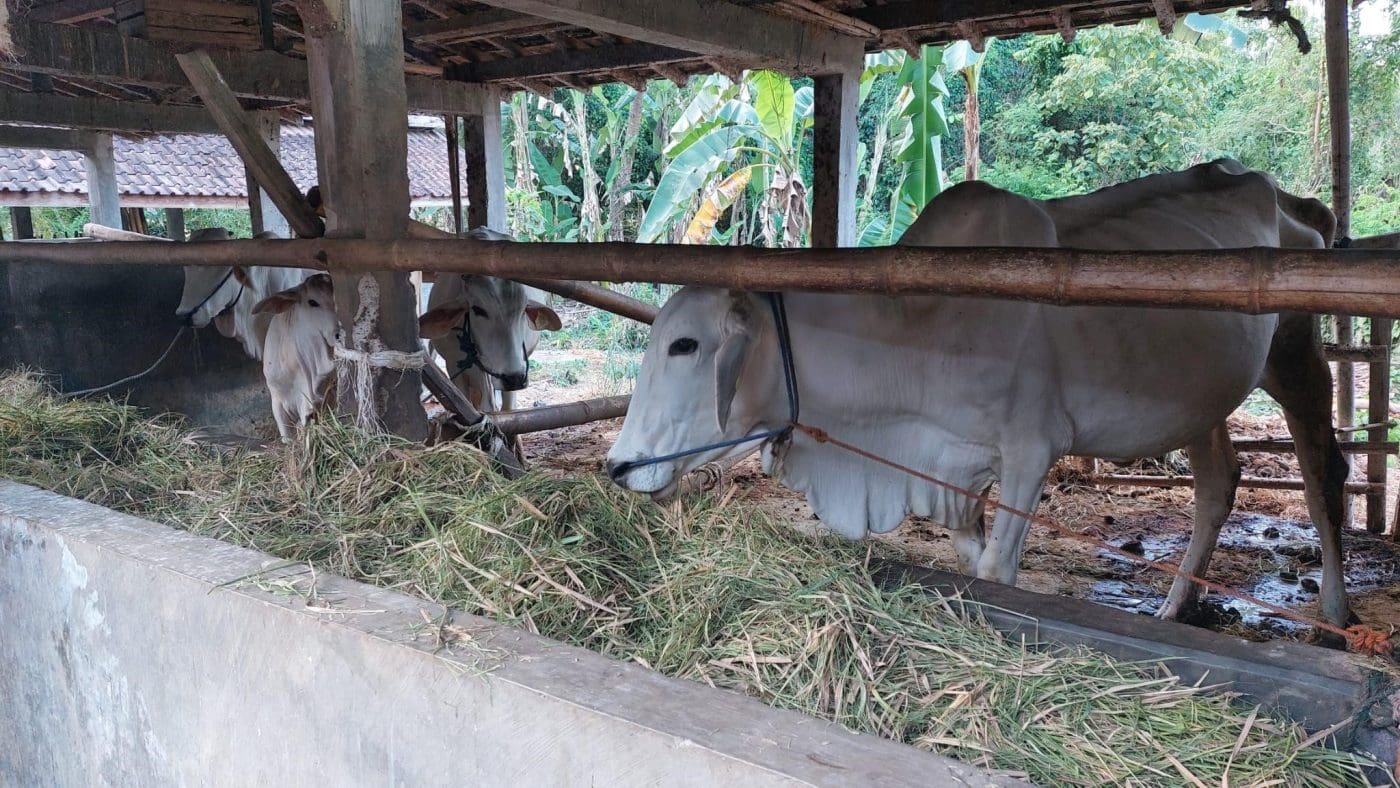
117th Edition: October 2023
Key points:
- Live export markets show promise with new client inquiries and the re-emergence of old ones.
- Beef demand in key export destinations remains largely unchanged.
- The Indonesia-Australia Red Meat Cattle Partnership (RMCP) nears major funding expiry after a decade of operation.
Regional Trends and Overview
The live export markets have been showing some promising signs lately, including new client inquiries and the re-emergence of old ones who had previously hunkered down during the high Australian cattle price cycle. Additionally, the approval of several ESCAS abattoirs is set to boost slaughtering capacity. However, this optimism should be tempered with caution. There hasn’t been a substantial change in beef demand from live cattle in key export destinations, and it remains doubtful that exports will rebound to pre-COVID levels.
A cursory look at the pricing graph reveals a distinct shift in pricing differentials between Australia and its closest live export markets. While these are early indications of a market rebound, they should be viewed as a positive yet preliminary signal, especially considering the prolonged period of challenging trading conditions we’ve faced.
One point of concern for the live export industry is the fluctuating nature of Australian export feeder cattle prices. This is particularly troubling given the North of Australia’s heavy reliance on live exports. Northern producers are faced not only with domestic issues, such as ongoing discussions around sheep exports, but also of greater threats from overseas markets.
Our pricing graph shows an interesting distinction in the relative stability of cattle prices in our trading destination markets which can be attributed to a range of differences between those markets and Australia. In Indonesia, for instance, the government continues to exercise significant control over the animal protein market, using trade agreements, disease control initiatives, and productivity programs that often undermine commercial investment capabilities. This kind of intervention complicates the historically symbiotic relationship between Australian suppliers and the Indonesian cattle industry, which has been dependent on efficient feedlots. These feedlots are being challenged by rising feed costs, and the abattoirs lack both the throughput volume and technical capabilities to compete with cheaper, imported frozen products. A similar scenario is unfolding across Asia.
Another often-overlooked factor is the role of local livestock industries. In countries like Indonesia and Vietnam, our estimates suggest that local cattle industries supply approximately two-thirds of the beef consumed. It’s conceivable that local wet market beef could continue to be supplied solely by local sources, as was the case before demand for local beef created a spike in demand and need for live export cattle.
So while there are some positive trends in the live export markets, things are not and never will be the same as they were. Especially given the complex landscape shaped by volatile prices, government intervention, and the role of local livestock industries.
Indonesia: Steers AUD $5.32 / kg live weight (IDR 9,866.83 = 1 AUD)
Despite various factors that could potentially impact beef prices in Indonesia—including international trade dynamics, biosecurity measures, and the observance of the Prophet Muhammad’s Birthday—the cost of beef has remained relatively stable. Cattle prices ranged from 56,000 to 58,000 IDR per kilogram of liveweight, while beef carcass prices at the start of October fluctuated between 91,000 and 97,000 IDR per kilogram. In the wet markets, beef prices saw a marginal increase of 0.35 percent on average, ranging from Rp129,450 to Rp134,980 per kilogram.
As mentioned above, the government has established a Maximum Retail Price (MRP) for cattle and beef. The published MPRs for different beef products vary. For example, the MRP for fore shank (hot carcass) stands at 130,000 IDR, while round and topsides (hot carcass) are priced at 140,000 IDR. Frozen chuck, blade, and shank have an MRP of 105,000 IDR, and frozen buffalo meat is capped at 80,000 IDR.
In political news, Indonesia experienced a significant upheaval last month. Minister of Agriculture Syahrul Yasin Limpo resigned following allegations of corruption, marking him as the sixth minister in President Joko Widodo’s cabinet to face such charges. While specific details remain under wraps, the resignation underscores Indonesia’s focus on anti-corruption efforts. President Widodo subsequently appointed Arief Prasetyo Adi, Head of the National Food Agency (Bapanas), as the acting Minister of Agriculture. With elections on the horizon in 2024, the political developments are likely to have far-reaching implications for agricultural businesses throughout Indonesia.
Meanwhile, the Lumpy Skin Disease (LSD) issue, which has taken a backseat in recent discussions, should not be considered fully resolved. A recent meeting between the Australian and Indonesian industries revealed continued ambiguity about the risks and monitoring measures for the trade. Given new uncontrolled outbreaks in Sumatra and restrictive vaccination policies, this issue could resurface and further complicate the trade relationship.
Given the importance of the relationship between Australia and Indonesia, the pending expiration of the Indonesia Australia Red Meat & Cattle Partnership (RMCP) in 2024 is cause for concern. Initiated in 2014 with a $60 million budget from the Australian government, this joint program has been vital in strengthening the red meat and live export ties between the two countries. As the program winds down and new projects cease to get approval, it raises pressing questions about what will replace this crucial funding and engagement mechanism.
Vietnam: Steers AUD $4.69 / kg live weight (VND15,550.67 = 1AUD)
The price of Australian cattle delivered to Vietnamese abattoirs remains cheaper than local cattle or those imported from Thailand and Laos. Prices for steers have fallen to VND 73,000 per kg of liveweight, and bulls to VND 74,504.50 per kg of liveweight. Meanwhile, hot beef sold in wet markets continues to wholesale at around VND 205,000 (AUD $13).
Interest from Vietnam in Australian live export cattle is growing, evidenced by frequent trips by importers to Australia for inspections and negotiations. Moreover, an increasing number of Vietnamese abattoirs are undergoing audits for ESCAS compliance, signaling importers’ intentions to expand their supply chains. However, caution is advised when commenting on supply chain expansion. Most Vietnamese abattoirs are operating at record-low throughput levels, as owners are hesitant to increase volumes. More throughput could mean a greater chance of unsold cattle or meat, thus leading to a general preference for maintaining low throughput levels and risk. As such, importers needing to process higher volumes of cattle with Australian shipments will need to secure approvals for additional abattoirs. However, relying on multiple small abattoirs can introduce risks, both in terms of commercial sustainability when local cattle prices change and animal welfare outcomes.
Australia’s Enhanced Economic Engagement Strategy (EEES) with Vietnam has given rise to two rounds of the Australia-Vietnam Enhanced Economic Grant (AVEG). Within this framework, two cattle projects are currently receiving funding. The first aims to directly assess Vietnamese cattle abattoirs to identify potential investment opportunities that could increase carcass throughput and value, or reduce environmental and animal welfare impacts. The second project, titled “Reimagining Innovation and Development of the Vietnam-Australian Beef Cattle Sectors,” focuses on fostering innovation, technical collaboration, trade, and investment between the two nations. A symposium for this project is scheduled in Hanoi for November 14-15.
Philippines: Slaughter Steers AUD $3.83 / kg liveweight (P. 35.94 = 1AUD)
There is no change in wet markets and supermarkets over the last month. Beef knuckle is trading at P. 560/kg and P. 600/kg retrospectively. Slaughter steer prices remain between P.130-145 /kg liveweight in Mindanao and hot carcass meat is around P.260 /kg. Note that prices are for local cattle bred and traded in Mindanao and not for Australian imported cattle.
It is unique to receive insights and feedback from my market reporter on the state of the Philippines market every month as it is always colourful and about how the people are feeling. Especially as the country has experienced some difficult times and instability in the last few years. The Philippines has started the last quarter of the year on a high note and September has been a very good month. Everybody is happy with good sales and the quarterly reports are looking good. From all accounts the country is headed for a last quarter “home run” with a long time of peace and good business. I think that says enough.
Thailand: Steers AUD $3.61(Tb 23.53 = 1 AUD)
Local steer prices continue a downward slide to Tb 85/kg ($3.95 AUD). The offtake into Vietnam and China remains uncertain and local Thai prices are potentially impacted by the drop in the Australian cattle price in Vietnam. In the region Australian cattle are mostly competing with cattle fed in Thai feedlots as they have a similar meat yield and appearance.
Feeder Steers Darwin $2.80 Townsville $2.40
The northern export feeder steer price has continued its downwards trend. Pricing for live export out of Darwin is of course always difficult to pin down. We would love to hear from producers who are seeing actual prices that differ from those we report here. In addition to a dramatic fall in prices producers are also grappling with the impact of ambiguity around the interpretation of rejection criteria for skin lesions which is having a significant impact on eligibility of cattle for export to Indonesia. The ASEL rejection criteria guidelines provide information on the requirements for rejecting animals based on skin lesions but allow for the application of “professional discretion” in interpreting the criteria. Challenging times for producers and livestock agents as they try to find a home for rejected cattle as well as traditional out-of-spec cattle and female cattle.
Another side of Indonesia’s livestock industry
My September was filled with what I can only presume is livestock conference season in Indonesia. I had the fortune of presenting at a goat breeders conference, which was also attended by some exporters from Australia and Dr Ross Ainsworth. The goat industry in Indonesia is interesting, mostly a hobby industry with dairy goats, there is a growing interest from locals in improving genetics and productivity. Like all livestock industries the main limitation is the ability for the goats to get to market as a high value product. The industry is fragmented with many small farmers.
At the event was the garut sheep agility art content where sheep are put against each other to demonstrate beauty and aggression. Similar to agriculture shows in Australia, the tradition binds the community together. It is also a place for testing sheep’s guts, a means of increasing class prestige, as well as rating the selling value of sheep belonging to breeders. The more often you win in the arena of action, the selling price of sheep will increase sharply, even reaching hundreds of millions of rupiah. The incredible part was there was no betting.
The 9th Silatnas Presidential Cup where the Indonesian Sheep and Goat Breeders Association (HPDKI) conference was held. Local garut sheep compete in the Sheep Agility Art contest.
I was also invited to present at was the Ildex conference in Jakarta on the future of the small abattoir in Asia (Indonesia). My pessimistic outlook on the local abattoir scene was unfortunately validated by those in the audience. And unfortunately the only silver bullet can come from a joint combination of large scale investment (from Australian companies… anyone?) and government regulation to close down abattoirs. This could result in higher throughput in fewer abattoirs and therefore more profit, while also increasing the standard of processing. The likelihood of this happening is low.
The other place I was able to attend was Jogja, this time viewing small holder cow and goat farms. When you get out to the provinces it is easier to see the real influence of Australian livestock and meat in the country. Australian livestock have a very specific place as higher quality and consistency products. But the volume comes from many cows kept and traded through exceptionally fragmented systems.
Local cow calf setup in Jogja. This farm worked like a cooperative and aggregated cows from all the neighbours. All cows were artificially inseminated for pregnancy.
2023 Year to August figures for sea freight across Asia for our different ports from the DAFF website.
| Country | NSW | NT | QLD | SA | VIC | WA | Grand Total |
| Brunei Darussalam | 6,652 | 35,496 | 4,124 | 4,620 | 50,892.00 | ||
| China | 3,805 | 1,860 | 658,053 | 68,604 | 732,322.00 | ||
| Indonesia | 8,139 | 1,517,647 | 630,012 | 7,739 | 576,280 | 2,739,817.00 | |
| Malaysia | 46,781 | 37,644 | 60,650 | 1,296 | 139,410 | 285,781.00 | |
| Philippines | 9,491 | 61,434 | 9,416 | 5,903 | 18,642 | 104,886.00 | |
| Sarawak | 1,297 | 12,522 | 1,381 | 203 | 400 | 15,803.00 | |
| Thailand | 597 | 1,720 | 3,343 | 769 | 5,568 | 11,997.00 | |
| Vietnam | 376 | 182,087 | 636,522 | 273 | 274,489 | 1,093,747.00 | |
| Grand Total | 73,333 | 1,848,550 | 1,288,603 | 62,510 | 674,236 | 1,088,013 | 5,035,245.00 |
Year to August for sea freight comparison across Asian markets from DAFF figures.
| Country | 2018 | 2019 | 2020 | 2021 | 2022 | 2023 | Grand Total |
| Brunei Darussalam | 4,070.00 | 5,599.00 | 8,458.00 | 21,488.00 | 7,603.00 | 3,674.00 | 50,892.00 |
| China | 141,277.00 | 163,715.00 | 134,010.00 | 100,034.00 | 142,557.00 | 50,729.00 | 732,322.00 |
| Indonesia | 604,048.00 | 674,270.00 | 471,519.00 | 415,655.00 | 347,306.00 | 227,019.00 | 2,739,817.00 |
| Malaysia | 70,357.00 | 66,860.00 | 56,431.00 | 46,779.00 | 23,966.00 | 21,388.00 | 285,781.00 |
| Philippines | 13,267.00 | 19,230.00 | 23,391.00 | 24,780.00 | 7,127.00 | 17,091.00 | 104,886.00 |
| Sarawak | 2,419.00 | 3,680.00 | 2,697.00 | 2,767.00 | 1,489.00 | 2,751.00 | 15,803.00 |
| Thailand | 2,110.00 | 2,069.00 | 2,142.00 | 2,170.00 | 1,827.00 | 1,679.00 | 11,997.00 |
| Vietnam | 206,491.00 | 281,105.00 | 301,830.00 | 166,647.00 | 58,242.00 | 79,432.00 | 1,093,747.00 |
| Grand Total | 1,044,039.00 | 1,216,528.00 | 1,000,478.00 | 780,320.00 | 590,117.00 | 403,763.00 | 5,035,245.00 |

